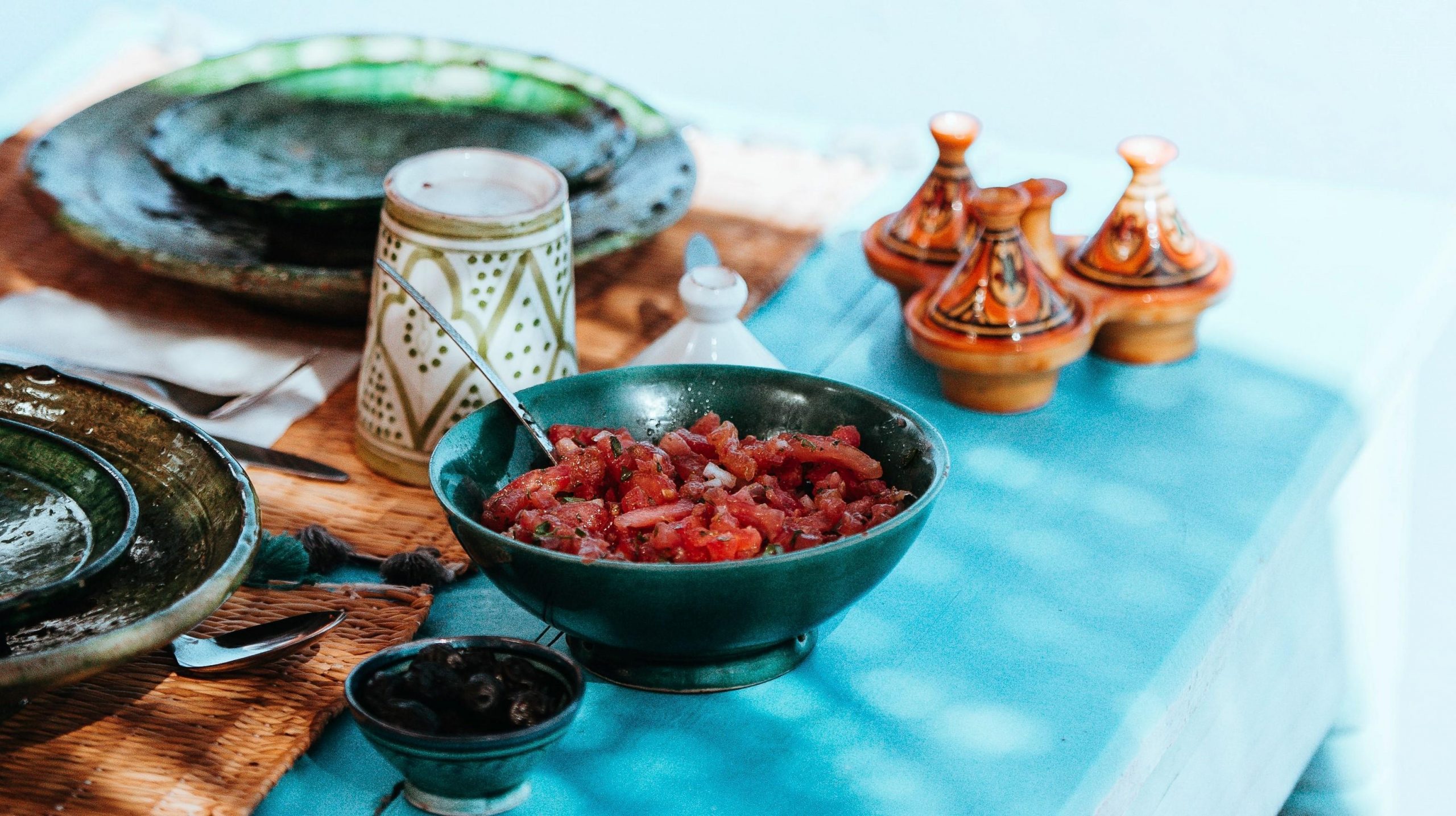
Not only cooking Moroccan food, but also with locals. In their home.
So here we are on a beautiful day in May, just a few days before the starting of Ramadan , but out here it’s just a normal day. It’s 10 AM and we are crossing Jemaa El Fna square in the company of Oumaina, our hostess for the day. The vendors are as busy as ever, enticing us with exotic juices, their stalls piled with heaps of oranges and grapefruits. Oumaima, whose English is sublime, is a student at Cadi Ayad university in Marrakech where she studies tourism.
Part- time she hosts cooking classes, but also handicraft workshops in zellij, babouche, tadelakt or pottery. She sounds very enthusiastic about the day ahead and her job in general. As we are stepping off the square she muses about her dreams to become a licensed guide in Marrakech, one of the first, if not the first female guide.

After a few twists and turns around the derbs of the bustling medina with its tourists, shop owners luring their clients in and donkeys pulling carts loaded with carpets, tagines or rubble, we make it to the small riad where the cooking will actually take place. By riad, I don’t mean the fancy guesthouses of Marrakech so popular with tourists nowadays. This is literally a local’s home where the lady of the house is preparing the tea.
Her niece, visiting from Spain, is on her way out, leaving her 1 year old baby in the capable hands of the house ladies. There are two common areas on the ground floor where the women spend most of the day, together with the kitchen. On the first floor, one can guess there are two or three more rooms which most likely are dispatched to young married couples. The men would have all gone out to their work earlier and probably would come back home late afternoon.

After passing on the invitation to tea, we head out back into the streets. Our next stop on our Moroccan cookery class? The butcher. Aicha, our cook for the day, joined us for the shopping. While Oumaima is busy describing every day life inside the house, Aicha stands in line waiting to purchase a bunch of chicken thighs. Once the chicken purchased, we slalom past the crowd into the open air souika, the colourful local market. We’ll need onions, lemons, parsley, tomatoes and aubergines. Aicha knows her providers and so she sorts the ingredients out. Some guests prefer skipping taking photos of the exotic stands and instead bargain for vegetables themselves…

Back on our tracks and across Place des Epices, where slave auctions used to take place in the not- so- distant past, we are heading towards the square, more precisely just behind it, where the preserved vegetables market takes shelter. Once our olives purchased, we are pressing on to the riad, just when the heat starts stifling.

Now it’s time for action. Aprons on, we are handed the necessary kitchen ware and off we go. It seems that I will be in charge of preparing the chicken tagine while my colleague will supervise the zaalouk, a popular tapenade made out of smoked aubergines, tomatoes and garlic. I’m a fiend for zaalouk so I will certainly peak in. Before anything else, Aicha sets about by rinsing the chicken parts… with lemon juice. By her account, the juice not only neuters all the germs but also renders the chicken tender throughout the cooking.

I start with placing the chicken thighs inside the tagine. Then, it’s the turn of the garlic which I chop really slender and sprinkle it over the chicken. Leila gives me a hand with chopping the parsley which is sprinkled next. Tears run down my cheeks thinking of the chicken that had to be sacrificed for our lunch… Joke apart, I’ve sliced so much onion that it completely shelters the chicken by now. Next, it’s time for decorating with olives, spice it with a little saffron powder and lastly, pour a good ladleful of olive oil over. Our cook tells us there’s no point in using water as the chicken will let out liquid while cooking.

We place the tagine over the fire, not before wedging a metal plate in between to help diffuse the heat of the direct flame and avoid cracking the adobe tagine. TIP: never expose the tagine stewer to direct flame and settle the flame as low as possible.

While the tagine is cooking, we place the aubergines next to the fire and turn them around so that they don’t burn. Once ready and pulled from the flame, Leila will sit down and peel them, before chopping them as fine as we can. We grind the tomatoes and the garlic and we mix it all with a good pinch of paprika, cumin, salt and pepper. We then place it all on the fire in a pan and slow cook it while mixing with a spoon occasionally. When I thought I played my part, Aicha showed up with a tray and informed me it was time for making Moroccan bread.

After sifting two kinds of flour and working the dough ( don’t ask me how to shed the dough off your fingers) it’s getting somewhat tricky to turn those lumps into perfect circles which are then to be shoved inside the oven, not before puncturing them with a fork.

And how long ago did we have tea ??? While the tagine and zaalouk are cooking and the bread is baking, we are being served another round. And it feels well deserved. Some half hour later everything is ready and lavishly spread on a table in the patio. Out of the two, I find the zaalouk to be the better. Bread lump in hand, we dig our fingers in the tagine, like locals do. The onion has completely sunk and caramelized and the chicken is as tender as it gets. I can finally brag about knowing how to make zaalouk, one of the staples of Moroccan cuisine…

Please note that such a class would take about 5 hours, lunch included. Cooking with the locals in Marrakech is offered as a choice of activities while on one of our bespoke Morocco tours.
© Sun Trails 2019. All rights reserved. No part of this article may be reproduced, distributed, or transmitted in any form, including photocopying, recording, or other electronic or mechanical methods, without the prior written permission of the publisher.


